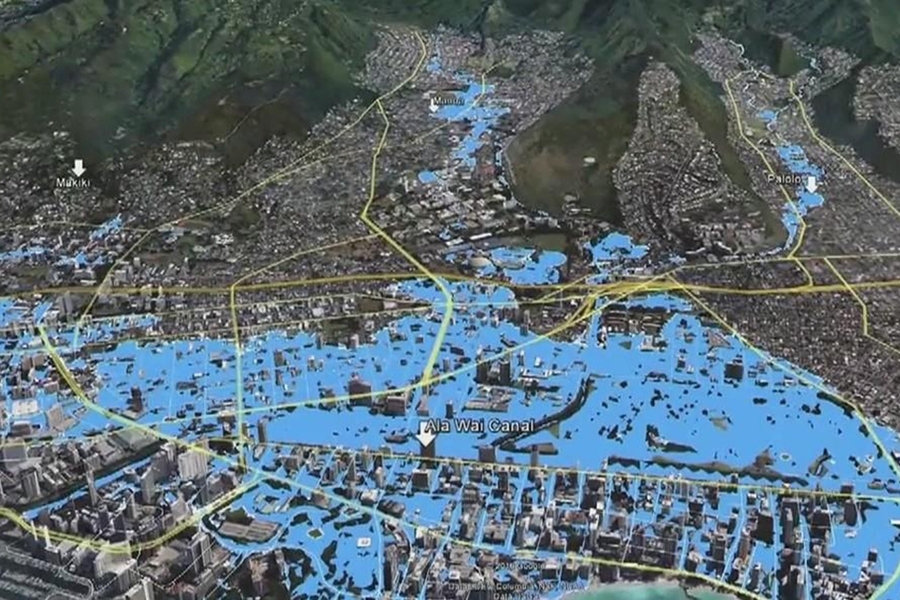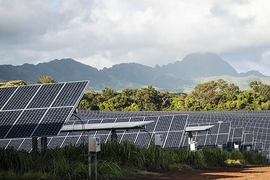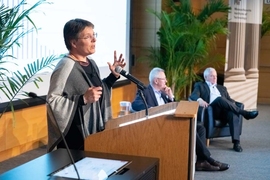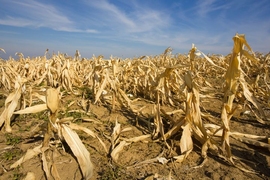Five-hundred-year floods. Persistent droughts and heat waves. More devastating wildfires. As these and other planetary perils become more commonplace, they pose serious risks to natural, managed, and built environments around the world. Assessing the magnitude of these risks over multiple decades and identifying strategies to prepare for them at local, regional, and national scales will be essential to making societies and economies more resilient and sustainable.
With that goal in mind, the MIT Joint Program on the Science of Global Change launched in 2019 its Adaptation-at-Scale initiative (AS-MIT), which seeks evidence-based solutions to global change-driven risks. Using its Integrated Global System Modeling (IGSM) framework, as well as a suite of resource and infrastructure assessment models, AS-MIT targets, diagnoses, and projects changing risks to life-sustaining resources under impending societal and environmental stressors, and evaluates the effectiveness of potential risk-reduction measures.
In pursuit of these objectives, MIT Joint Program researchers are collaborating with other adaptation-at-scale thought leaders across MIT. And at a conference on Jan. 10 on the MIT campus, they showcased some of their most promising efforts in this space. Part of a series of MIT Joint Program workshops aimed at providing decision-makers with actionable information on key global change concerns, the conference covered risks and resilience strategies for food, energy, and water systems; urban-scale solutions; predicting the evolving risk of extreme events; and decision-making and early warning capabilities — and featured a lunch seminar on renewable energy for resilience and adaptation by an expert from the National Renewable Energy Laboratory.
Food, energy, and water systems
Greg Sixt, research manager in the Abdul Latif Jameel Water and Food Systems Lab (J-WAFS), described the work of J-WAFS’ Alliance for Climate Change and Food Systems Research, an emerging alliance of premier research institutions and key stakeholders to collaboratively frame challenges, identify research paths, and fund and pursue convergence research on building more resilience across the food system, from production to supply chains to consumption.
MIT Joint Program Deputy Director Sergey Paltsev, also a senior research scientist at the MIT Energy Initiative (MITEI), explored climate-related risks to energy systems. He highlighted physical risks, such as potential impacts of permafrost degradation on roads, airports, natural gas pipelines, and other infrastructure in the Arctic, and of an increase in extreme temperature, wind, and icing events on power distribution infrastructure in the U.S. Northeast.
“No matter what we do in terms of climate mitigation, the physical risks will remain the same for decades because of inertia in the climate system,” says Paltsev. “Even with very aggressive emissions-reduction policies, decision-makers must take physical risks into consideration.”
They must also account for transition risks — long-term financial and investment risks to fossil fuel infrastructure posed by climate policies. Paltsev showed how energy scenarios developed at MIT and elsewhere can enable decision-makers to assess the physical and financial risks of climate change and of efforts to transition to a low-carbon economy.
MIT Joint Program Deputy Director Adam Schlosser discussed MIT Joint Program (JP) efforts to assess risks to, and optimal adaptation strategies for, water systems subject to drought, flooding, and other challenges impacting water availability and quality posed by a changing environment. Schlosser noted that in some cases, efficiency improvements can go a long way in meeting these challenges, as shown in one JP study that found improving municipal and industrial efficiencies was just as effective as climate mitigation in confronting projected water shortages in Asia. Finally, he introduced a new JP project funded by the U.S. Department of Energy that will explore how in U.S. floodplains, foresight could increase resilience to future forces, stressors, and disturbances imposed by nature and human activity.
“In assessing how we avoid and adapt to risk, we need to think about all plausible futures,” says Schlosser. “Our approach is to take all [of those] futures, put them into our [integrated global] system of human and natural systems, and think about how we use water optimally.”
Urban-scale solutions
Brian Goldberg, assistant director of the MIT Office of Sustainability, detailed MIT’s plans to sustain MIT campus infrastructure amid intensifying climate disruptions and impacts over the next 100 years. Toward that end, the MIT Climate Resiliency Committee is working to shore up multiple, interdependent layers of resiliency that include the campus site, infrastructure and utilities, buildings, and community, and creating modeling tools to evaluate flood risk.
“We’re using the campus as a testbed to develop solutions, advance research, and ultimately grow a more climate-resilient campus,” says Goldberg. “Perhaps the models we develop and engage with at the campus scale can then influence the city or region scale and then be shared globally.”
MIT Joint Program/MITEI Research Scientist Mei Yuan described an upcoming study to assess the potential of the building sector to reduce its greenhouse gas emissions through more energy-efficient design and intelligent telecommunications — and thereby lower climate-related risk to urban infrastructure. Yuan aims to achieve this objective by linking the program’ s U.S. Regional Energy Policy (USREP) model with a detailed building sector model that explicitly represents energy-consuming technologies (e.g., for heating, cooling, lighting, and household appliances).
“Incorporating this building sector model within an integrated framework that combines USREP with an hourly electricity dispatch model (EleMod) could enable us to simulate the supply and demand of electricity at finer spatial and temporal resolution,” says Yuan, “and thereby better understand how the power sector will need to adapt to future energy needs.”
Renewable energy for resilience and adaptation
Jill Engel-Cox, director of NREL’s Joint Institute for Strategic Energy Analysis, presented several promising adaptation measures for energy resilience that incorporate renewables. These include placing critical power lines underground; increasing demand-side energy efficiency to decrease energy consumption and power system instability; diversifying generation so electric power distribution can be sustained when one power source is down; deploying distributed generation (e.g., photovoltaics, small wind turbines, energy storage systems) so that if one part of the grid is disconnected, other parts continue to function; and implementing smart grids and micro-grids.
“Adaptation and resilience measures tend to be very localized,” says Engel-Cox. “So we need to come up with strategies that will work for particular locations and risks.”
These include storm-proofing photovoltaics and wind turbine systems, deploying hydropower with greater flexibility to account for variability in water flow, incorporating renewables in planning for natural gas system outages, and co-locating wind and PV systems on agricultural land.
Extreme events
MIT Joint Program Principal Research Scientist Xiang Gao showed how a statistical method that she developed has produced predictions of the risk of heavy precipitation, heat waves, and other extreme weather events that are more consistent with observations than conventional climate models do. Known as the “analog method,” the technique detects extreme events based on large-scale atmospheric patterns associated with such events.
“Improved prediction of extreme weather events enabled by the analog method offers a promising pathway to provide meaningful climate mitigation and adaptation actions,” says Gao.
Sai Ravela, a principal research scientist at MIT’s Department of Earth, Atmospheric and Planetary Sciences, showed how artificial intelligence could be exploited to predict extreme events. Key methods that Ravela and his research group are developing combine climate statistics, atmospheric modeling, and physics to assess the risk of future extreme events. The group’s long-range predictions draw upon deep learning and small-sample statistics using local sensor data and global oscillations. Applying these methods, Ravela and his co-investigators are developing a model to assess the risk of extreme weather events to infrastructure, such as that of wind and flooding damage to a nuclear plant or city.
Decision-making and early warning capabilities
MIT Joint Program/MITEI Research Scientist Jennifer Morris explored uncertainty and decision-making for adaptation to global change-driven challenges ranging from coastal adaptation to grid resilience. Morris described the MIT Joint Program approach as a four-step process: quantify stressors and influences, evaluate vulnerabilities, identify response options and transition pathways, and develop decision-making frameworks. She then used the following Q&A to show how this four-pronged approach can be applied to the case of grid resilience.
Q: Do human-induced changes in damaging weather events present a rising, widespread risk of premature failure in the nation’s power grid — and, if so, what are the cost-effective near-term actions to hedge against that risk?
A: First, identify critical junctures within power grid, starting with large power transformers (LPTs). Next, use an analogue approach (described above) to construct distribution of expected changes in extreme heat wave events which would be damaging to LPTs under different climate scenarios. Next, use energy-economic and electric power models to assess electricity demand and economic costs related to LPT failure. And finally, make decisions under uncertainty to identify near-term actions to mitigate risks of LPT failure (e.g., upgrading or replacing LPTs).
John Aldridge, assistant leader of the Humanitarian Assistance and Disaster Relief Systems Group at MIT Lincoln Laboratory, highlighted the group’s efforts to combine advanced remote sensing and decision support systems to assess the impacts of natural disasters, support hurricane evacuation decision-making, and guide proactive climate adaptation and resilience. Lincoln Laboratory is collaborating with MIT campus partners to develop the Climate Resilience Early Warning System Network (CREWSNET), which draws on MIT strengths in cutting-edge climate forecasting, impact models, and applied decision support tools to empower climate resilience and adaptation on a global scale.
“From extreme event prediction to scenario-based risk analysis, this workshop showcased the core capabilities of the joint program and its partners across MIT that can advance scalable solutions to adaptation challenges across the globe,” says Adam Schlosser, who coordinated the day’s presentations. “Applying leading-edge modeling tools, our research is well-positioned to provide decision-makers with guidance and strategies to build a more resilient future."









